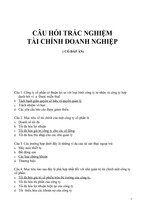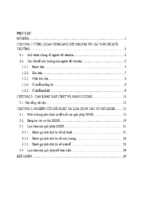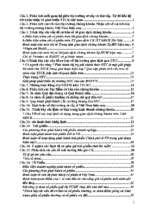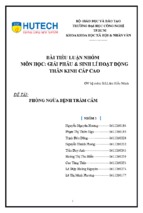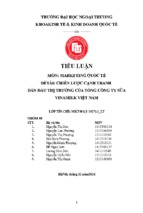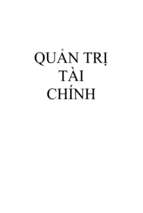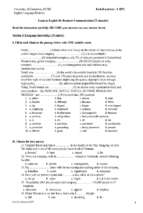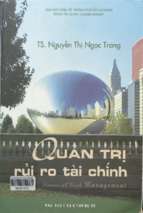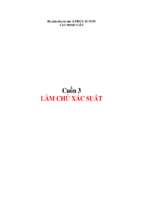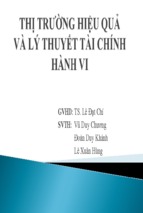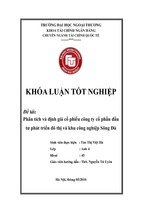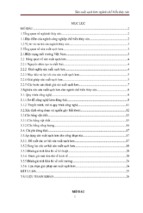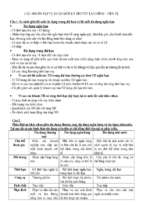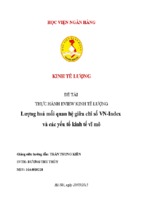Contents
1 Introduction
1.1 Example: traffic modeling . . .
1.2 Example: interpoint distances
1.3 Notation . . . . . . . . . . . .
1.4 Outline of the book . . . . . .
End notes . . . . . . . . . . . . . . .
Exercises . . . . . . . . . . . . . . .
.
.
.
.
.
.
.
.
.
.
.
.
.
.
.
.
.
.
.
.
.
.
.
.
.
.
.
.
.
.
.
.
.
.
.
.
.
.
.
.
.
.
.
.
.
.
.
.
.
.
.
.
.
.
.
.
.
.
.
.
.
.
.
.
.
.
.
.
.
.
.
.
.
.
.
.
.
.
.
.
.
.
.
.
.
.
.
.
.
.
.
.
.
.
.
.
.
.
.
.
.
.
3
3
5
7
7
9
11
2 Simple Monte Carlo
2.1 Accuracy of simple Monte Carlo . .
2.2 Error estimation . . . . . . . . . . .
2.3 Safely computing the standard error
2.4 Estimating probabilities . . . . . . .
2.5 Estimating quantiles . . . . . . . . .
2.6 Random sample size . . . . . . . . .
2.7 Estimating ratios . . . . . . . . . . .
2.8 When Monte Carlo fails . . . . . . .
2.9 Chebychev and Hoeffding intervals .
End notes . . . . . . . . . . . . . . . . . .
Exercises . . . . . . . . . . . . . . . . . .
.
.
.
.
.
.
.
.
.
.
.
.
.
.
.
.
.
.
.
.
.
.
.
.
.
.
.
.
.
.
.
.
.
.
.
.
.
.
.
.
.
.
.
.
.
.
.
.
.
.
.
.
.
.
.
.
.
.
.
.
.
.
.
.
.
.
.
.
.
.
.
.
.
.
.
.
.
.
.
.
.
.
.
.
.
.
.
.
.
.
.
.
.
.
.
.
.
.
.
.
.
.
.
.
.
.
.
.
.
.
.
.
.
.
.
.
.
.
.
.
.
.
.
.
.
.
.
.
.
.
.
.
.
.
.
.
.
.
.
.
.
.
.
.
.
.
.
.
.
.
.
.
.
.
.
.
.
.
.
.
.
.
.
.
.
.
.
.
.
.
.
.
.
.
.
.
15
15
18
21
22
24
28
29
31
33
35
39
1
.
.
.
.
.
.
.
.
.
.
.
.
2
Contents
© Art Owen 2009–2013
do not distribute or post electronically without
author’s permission
1
Introduction
This is a book about the Monte Carlo method. The core idea of Monte Carlo is
to learn about a system by simulating it with random sampling. That approach
is powerful, flexible and very direct. It is often the simplest way to solve a
problem, and sometimes the only feasible way.
The Monte Carlo method is used in almost every quantitative subject of
study: physical sciences, engineering, statistics, finance, and computing, including machine learning and graphics. Monte Carlo is even applied in some areas,
like music theory, that are not always thought of as quantitative.
The Monte Carlo method is both interesting and useful. In this book we will
look at the ideas behind Monte Carlo sampling and relate them to each other.
We will look at the mathematical properties of the methods to understand when
and why they work. We will also look at some important practical details that
we need to know in order to get reliable answers to serious problems. Often the
best way to see the ideas and practical details is through an example, and so
worked examples are included throughout.
1.1
Example: traffic modeling
Monte Carlo methods have proven useful in studying how vehicle traffic behaves.
Perhaps the most interesting aspect of traffic is the occurrence of traffic jams.
At places where the number of traffic lanes is reduced, cars slow down and form
a blockage. Similarly, accidents or poor visibility or the occasional slow vehicle
can bring about a traffic jam.
Sometimes, however, a traffic jam has no apparent cause. It just spontaneously appears in flowing traffic, and moves slowly backwards against the
traffic. It can last a long time and then simply disappear.
3
4
1. Introduction
The phenomenon can be illustrated with Monte Carlo methods. A very
simple Monte Carlo simulation that captures some of the important properties
of real traffic is the Nagel-Schreckenberg model. In this model the roadway is
divided up into M distinct zones, each of which can hold one vehicle. There
are N vehicles in the road. Time moves forward in discrete steps. A vehicle
with velocity v moves ahead by v zones in the roadway at the next time step.
There is a maximum speed vmax which all vehicles obey. In the simplest case,
the roadway is a circular loop.
The rules for Nagel-Schreckenberg traffic are as follows. At each stage
of the simulation, every car goes through the following four steps. First, if its
velocity is below vmax , it increases its velocity by one unit. The drivers are eager
to move ahead. Second, it checks the distance to the car in front of it. If that
distance is d spaces and the car has velocity v > d then it reduces its velocity
to d − 1 in order to avoid collision. Third, if the velocity is positive then with
probability p it reduces velocity by 1 unit. This is the key step which models
random driver behavior. At the fourth step, the car moves ahead by v units to
complete the stage. These four steps take place in parallel for all N vehicles.
Let x ∈ {0, 1, . . . , M − 1} be the position of a car, v its velocity, and d be
the distance to the car ahead. The update for this car is:
v ← min(v + 1, vmax )
v ← min(v, d − 1)
v ← max(0, v − 1)
with probability p
(1.1)
x ← x + v.
At the last step, if x + v > M then x ← x + v − M . Similarly, for the car with
the largest x, the value of d is M plus the smallest x, minus the largest x.
Figure 1.1 shows a sample realization of this process. It had N = 100 vehicles
in a circular track of M = 1000 spaces. The speed limit was vmax = 5 and the
probability of random slowing was p = 1/3. The initial conditions are described
on page 10 of the chapter end notes. The figure clearly shows some traffic jams
spontaneously appearing, then drifting backward, and then disappearing. We
can also see some smaller congestions which move slowly forward over time. The
white stripes are unusually wide gaps between cars. These gaps move at nearly
the speed limit.
Obviously, real traffic is much more complicated than this model. The NagelSchreckenberg model has been extended to have multiple lanes. It and other
models can be applied on arbitrarily large road networks for cars having different
random sources, destinations and speeds. The much more realistic models can
be used to make predictions of the effects of adding a lane, temporarily closing
a city street, putting metering lights at a freeway on-ramp, and so on. Adding
such realism requires considerable domain knowledge about traffic and lots of
computer code and documentation. Monte Carlo methods are then a small but
important ingredient in the solution.
The extreme simplicity of the Nagel-Schreckenberg model provides one advantage. There is no bottleneck, no accident, or other phenomenon to explain
© Art Owen 2009–2013
do not distribute or post electronically without
author’s permission
1.1. Example: traffic modeling
5
Time
Nagel−Schreckenberg traffic
Distance
Figure 1.1: This figure illustrates a Monte Carlo simulation of the NagelSchreckenberg traffic model as described in the text. The simulation starts
with 100 cars represented as black dots on the top row. The vehicles move
from left to right, as time increases from top to bottom. Traffic jams emerge
spontaneously. They show up as dark diagonal bands. The traffic jams move
backward as the traffic moves forward.
the traffic jams. There is no particularly bad driver, because they all follow the
same algorithm. Even without any of that complexity, a bit of random slowing
is enough to cause stop-and-go traffic patterns to emerge and then dissipate.
The other advantage of very simple models is pedagogic. They bring the
Monte Carlo issues to the forefront. A full description of the non-Monte Carlo
issues in a realistic simulation could well be larger than this whole book.
In the traffic example, the emphasis is on making a picture to get qualitative
© Art Owen 2009–2013
do not distribute or post electronically without
author’s permission
6
1. Introduction
insight. Such visualization is a very common use of Monte Carlo methods.
Sometimes the picture is the goal in itself. For example, Monte Carlo methods
are widely used in the making of movies, and Oscars have even been awarded
for progress in Monte Carlo methods.
Usually when we see a feature in a picture we want a quantitative measure
of it. It is more typical for Monte Carlo investigations to be aimed at getting
a number, rather than making a picture, though we may well want both. Exercise 1.1 asks you to make numerical measurements of the traffic flow under
various versions of the Nagel-Schreckenberg model.
1.2
Example: interpoint distances
In this section we give an example where Monte Carlo methods are used to
estimate a number. The specific example we will use is one where we already
know the answer. That lets us check our solution. Of course, most of this book
is about problems where we don’t already know the answer
Our example here is the average distance between randomly chosen points
in a region. Such average distances come up in many settings. For biologists,
the energy that a bird has to spend to guard its territory depends on the average distance from its nest to points in that area. In wireless networks, the
probability that a distributed network is fully connected depends on average
distances between communicating nodes. The average distances from dwellings
to fire stations or doctors are also of interest.
To focus on essentials, suppose that X = (X1 , X2 ) and Z = (Z1 , Z2 ) are
independent and uniformly distributed
p random points in a finite rectangle R =
[0, a] × [0, b]. Let Y = d(X, Z) = (X1 − Z1 )2 + (X2 − Z2 )2 be the Euclidean
distance between X and Z. We can approximate the expected value of d(X, Z)
by sampling pairs of points (Xi , Zi ) for i = 1, . . . , n and taking the average
n
1X
d(Xi , Zi ).
n i=1
(1.2)
Perhaps surprisingly, the exact value of E(d(X, Z)) is already known in
closed form, and we’ll use it to see how well Monte Carlo performs. Ghosh
(1951) shows that the expected distance is
"
�#
�
1 a3
b3 p 2
a2
b2
2
G(a, b) =
+ 2 + a +b 3− 2 − 2
15 b2
a
b
a
"
p
�
�
�p 2
�# (1.3)
a2 + b2
a + b2
1 b2
a2
+
arccosh
+
arccosh
,
6 a
b
b
a
where
arccosh(t) = log t +
© Art Owen 2009–2013
p
�
t2 − 1
do not distribute or post electronically without
author’s permission
1.3. Notation
7
is the upper branch of the hyperbolic arc cosine function.
For many problems, closed form expressions like equation (1.3) simply don’t
exist. When they do, they can be very hard to derive.
Exact solutions, like equation (1.3), are also very brittle. If we make a small
change in the problem, then it may become impossible to get an exact solution.
In an application, we might need to study a non-rectangular region, or use a
non-uniform distribution on the region of interest, measure distance in terms of
travel time, or even take points from a grid of data, such as street intersections
in California. Changes like this can completely wreck a closed form solution.
The situation is much more favorable for Monte Carlo. We can make a series
of small changes in the way that the points are sampled or in the way that the
distance is measured. With each change, the problem we’re solving more closely
fits the problem we set out to solve.
Consider X and Z independent and uniformly distributed in the rectangle
.
.
[0, 1] × [0, 3/5]. Equation (1.3) gives E(d(X, Y )) = 0.4239 where = denotes
numerical rounding. It takes very little time to generate n = 10,000 pairs of
points Xi , Zi ∈ [0, 1] × [0, 3/5], for 1 6 i 6 10,000. Doing this simulation one
.
b
time and using equation (1.2) gave the estimate E(d)
= 0.4227. The relative
.
b
error in this estimate is |E(d)
− E(d)|/E(d) = 0.0027.
In this case a small error was obtained from only 10,000 evaluations. It also
takes very little time to program this simulation in a computing environment
such as R or Matlab, among others. Simple Monte Carlo worked very well in
this example. It was not just a lucky set of random numbers either. We defer
an analysis to Chapter 2. There we will look closely at the accuracy of simple
Monte Carlo, how it compares to competing methods, when it fails, and how
we can estimate the error from the same sample values we use to estimate E(d).
1.3
Notation
Much of the notation in this book is introduced at the point where it is needed.
Here we present some notational conventions that are used throughout the book,
including the previous examples. The sets of real numbers and integers are
denoted by R and Z respectively. Sets Rd and Zd are then d-tuples of reals or
integers respectively. This means, without always saying it, that d is an integer
and d > 1. Whenever d = ∞ or even d = 0 is necessary, there will be a remark.
A d-tuple of real numbers is denoted in bold type, such as x, y, or z. We
write x = (x1 , . . . , xd ) to show the components xj of x. We will call these
tuples vectors because that term is more familiar. But unless x takes part in
vector or matrix products we don’t distinguish between the vector x and its
transpose xT . In most instances x is simply a list of d numbers used as inputs
to a function. Thus, we can concatenate x and y by writing (x, y) instead of
the more cumbersome (xT , y T )T . When d = 1, we could equally well use x or x.
A finite sequence of vectors is denoted x1 , . . . , xn , and an infinite sequence
by xi for i > 1. The components of xi are denoted xij . Thus x7 is the seventh
element of a generic vector x while x7 is the seventh vector in a sequence.
© Art Owen 2009–2013
do not distribute or post electronically without
author’s permission
8
1. Introduction
Random numbers and vectors are usually denoted by capital letters. Then,
for example, P(X = x) is the probability that the random vector X ∈ Rd
happens to equal the specific
(nonrandom) vector x ∈ Rd . A typical Monte
Pn
Carlo P
estimate is (1/n) i=1 f (xi ) for xi ∈ Rd . It is the observed outcome of
n
(1/n) i=1 f (Xi ) for random Xi ∈ Rd . We will study the mean and variance
of Monte Carlo estimates, meaning the latter expression.
We write A ∈ Rm×n when A is an m by n matrix of real numbers. Similarly
a matrix of nonnegative numbers or binary values is an element of [0, ∞)m×n or
{0, 1}m×n , respectively. The elements of A are Aij for 1 6 i 6 m and 1 6 j 6
n. We rarely need sequences of matrices and rarely need to compare random
matrices to their observed values. Notation for these special uses is spelled
out where they arise. Also, Greek letters will not necessarily be capitalized or
printed in bold.
The mean and variance of a random quantity X ∈ R are written E(X)
and Var(X) respectively. The covariance of real random variables X and Y
is Cov(X, Y ). When X ∈ Rd then E(X) ∈ Rd and Var(X) ∈ Rd×d . The ij
element of Var(X) is Cov(Xi , Xj ).
1.4
Outline of the book
The examples in this chapter used what is called simple Monte Carlo, or sometimes crude Monte Carlo. Chapter 2 explains how simple Monte Carlo works
in detail. It is mainly focussed on how accurate simple Monte Carlo is. It also
considers what might go wrong with simple Monte Carlo.
The next block of chapters describes what we have to know in order to use
simple Monte Carlo. To begin with, we need a source of randomness. Chapter 3
describes how to simulate independent random samples from the U(0, 1) distribution, or rather, how to make effective use of a random number generator.
Chapter 4 describes how to turn U(0, 1) random variables into non-uniform ones
such as normal or Poisson random variables. That chapter covers most of the
important distributions that come up in practice and, should the need arise for
a brand new distribution, the general methods there can be applied. Random
vectors are more complicated than random numbers because of the dependence
properties linking their components. Chapter 5 shows how to sample random
vectors, as well as some other random objects like rotations and permutations.
The final chapter of this block is Chapter 6 which describes how to sample random processes. We need such methods, for example, when what we’re sampling
evolves in time and there is no fixed bound on the number of steps that have to
be simulated.
Monte Carlo methods are usually presented as estimates of averages which
in turn are integrals. Sometimes we can get a better answer using classical
numerical integration instead of Monte Carlo. A few of the most useful quadrature methods are described in Chapter 7. In special settings we may use them
instead of, or in combination with Monte Carlo.
Having worked out how to use Monte Carlo sampling, the next step is to
© Art Owen 2009–2013
do not distribute or post electronically without
author’s permission
End Notes
9
see how to improve upon it. Monte Carlo can be very slow to converge on some
problems. Chapter 8 describes basic variance reduction techniques, including
antithetic sampling, control variates, and stratification, that can give rise to
faster convergence than crude Monte Carlo. An entire chapter, Chapter 9,
is devoted to importance sampling. This variance reduction method is much
harder to use than the others. Sometimes importance sampling brings enormous
variance reductions and in other circumstances it delivers an estimate with
infinite variance. Some more advanced variance reduction methods are described
in Chapter 10.
There are problems that are too hard to solve by simple Monte Carlo even
with all the variance reduction methods at our disposal. There are two principal
sources of this difficulty. Sometimes we cannot find any practical way to make
independent samples of the random inputs we need. In other settings, we can
draw the samples, but the resulting Monte Carlo estimate is still not accurate
enough.
Markov Chain Monte Carlo (MCMC) methods have been developed to address the first of these problems. Instead of sampling independent points, it
samples from a Markov chain whose limiting distribution is the one we want.
Chapter 11 presents basic theory of Markov Chain Monte Carlo, focussing on
the Metropolis-Hastings algorithm. Chapter 12 describes the Gibbs sampler.
MCMC greatly expands the range of problems that Monte Carlo methods
can handle. We can trace the roots of MCMC to the ideas used in generating
random variables, particularly acceptance rejection sampling.
The second difficulty for Monte Carlo methods is that they can be slow
to converge. We √
will see in Chapter 2 that the error typically decreases proportionally to 1/ n when we use n function evaluations. Quasi-Monte Carlo
(QMC) and related methods improve the accuracy of Monte Carlo. The methods
grow out of variance reduction methods, especially stratification. Quasi-Monte
Carlo is introduced in Chapter 15 which focuses on digital net constructions.
Chapter 16 presents lattice rules. QMC is deterministic and error estimation
is difficult for it. Chapter 17 presents randomized quasi-Monte Carlo (RQMC)
methods. These retain the accuracy of QMC while allowing independent replication for error estimation. In certain circumstances RQMC is even more accurate
than QMC.
Chapter end notes
History of Monte Carlo
The Monte Carlo method has a long history. In statistics it was called ‘model
sampling’ and used to verify the properties of estimates by mimicking the settings for which they were designed. W. S. Gosset, writing as Student (1908)
derived what is now called Student’s t distribution. Before finding his analytic
result, he did some simulations, using height and left middle finger measurements from 3000 criminals as written on pieces of cardboard. Tippett (1927) is
© Art Owen 2009–2013
do not distribute or post electronically without
author’s permission
10
1. Introduction
an early source of numbers to use as if they were random in sampling.
Sampling was also used by physicists. Hammersley and Handscomb (1964)
describe some computations done by Kelvin (1901) on the Boltzmann equation.
There is more history in Kalos and Whitlock (2008) including computations
made by Fermi in the 1930s. An even earlier idea was the famous Buffon needle
method for estimating π by throwing needles randomly on a wooden floor and
counting the fraction of needles that touch the line between two planks.
Monte Carlo sampling became far more prominent in the 1940s and early
1950s. It was used to solve problems in physics related to atomic weapons. The
name itself is from this era, taken from the famous casino located in Monte
Carlo. Many of the problems studied had a deterministic origin. By now it
is standard to use random sampling on problems stated deterministically but
early on that was a major innovation, and was even considered to be part of the
definition of a Monte Carlo method.
There are numerous landmark papers in which the Monte Carlo method
catches on and becomes widely used for a new class of problems. Here are
some examples. Metropolis et al. (1953) present the Metropolis algorithm, the
first Markov chain Monte Carlo method, for studying the relative positions of
atoms. Tocher and Owen (1960) describe the GSP software (since superceded)
for discrete event simulation of queues and industrial processes. Boyle (1977)
shows how to use Monte Carlo methods to value financial options. Gillespie
(1977) uses Monte Carlo simulation for chemical reactions in which the number
of molecules is so small that differential equations are not accurate enough
to describe them. Efron’s (1979) bootstrap uses Monte Carlo sampling to give
statistical answers with few distributional assumptions. Kirkpatrick et al. (1983)
introduce simulated annealing, a Monte Carlo method for optimizing very nonsmooth functions. Kajiya (1988) introduces a Monte Carlo method called path
tracing for graphical rendering. Tanner and Wong (1987) use Monte Carlo
algorithms to cope with problems of missing data. The realization that Markov
chain Monte Carlo could be transformative for Bayesian statistical problems can
be traced to Geman and Geman (1984) and Gelfand and Smith (1990) among
others.
There are undoubtedly more major milestones that could be added to the
list above and most of those ideas had precursors. Additional references are
given in other Chapters, though not every work could be cited.
Quasi-Monte Carlo is approximately as old as Monte Carlo. The term itself
was coined by Richtmyer (1952) who thought that Monte Carlo would be improved by using sequences with better uniformity than truly random sequences
would have. The measurement of uniformity of sequences goes back to Weyl
(1914, 1916).
Traffic modeling
The Nagel-Schreckenberg model was proposed in Nagel and Schreckenberg (1992).
A comprehensive survey of traffic modeling approaches based on physics appears
© Art Owen 2009–2013
do not distribute or post electronically without
author’s permission
Exercises
11
in Chowdhury et al. (2000). Traffic appears as particles in some of the models
and as a fluid in some others.
The description of the Nagel-Schreckenberg model in Chapter 1.1 left out
the initial conditions. Here is how the data were sampled. First the N cars
were placed into the M slots by sampling N values from 0 to M − 1 without
replacement. Methods for doing this are described in §5.11. Such sampling is
already built-in to many computing environments. The N cars are started with
initial velocity v = 0. Then 2500 updates were run in a ‘burn-in’ period. Then
the 1000 time periods shown in the figure were computed.
Technical Oscars
Ken Perlin won a technical Oscar in 1997 for his work on ‘solid noise’ also called
Perlin noise. That work was featured in the 1982 movie Tron. In 2003, Thomas
Driemeyer and his team at mental images won a technical Oscar for Mental Ray
rendering software. Mental Ray uses quasi-Monte Carlo.
Random distances
Ghosh (1951) finds more than just the mean distance. He finds the probability
density function of the distance d, as well as E(dk ) for k = 1, 2, 3, 4. For the
density function,
pthree different formulas are required, one for each of the ranges
[0, b), [b, a), [a, a2 + b2 ].
Much of Ghosh’s paper is concerned with the two rectangle problem. The
points X and Z are sampled from two different and possibly overlapping rectangles, with parallel sides. The density function of d(X, Z) takes 15 different
formulas on 15 different ranges. Instead of handling all of these cases, Ghosh
considers special versions of the problem such as the one in which the rectangles
are congruent squares touching at a corner or at a side. Marsaglia et al. (1990)
give a survey of random distances in rectangles, including many from before
Ghosh. They include figures of the probability density of those distances for
rectangles with varying relative sizes and amounts of overlap.
The average distance between two independent and uniformly distributed
points in [0, 1]3 is known as the Robbins constant after Robbins (1978). It is
i
√
√
√
√
1 h
∆(3) =
4 + 17 2 − 6 3 + 21 log(1 + 2) + 42 log(2 + 3) − 7π
105
.
= 0.66160.
(1.4)
While the mean is known, the probability density of the three dimensional
random distance was not known as of 2005 (Weisstein, 2005).
Exercises
These exercises require the use of random number generators. The basics of
random number generators are described in Chapter 3. The exercises in this
© Art Owen 2009–2013
do not distribute or post electronically without
author’s permission
12
1. Introduction
chapter do not require sophisticated uses of random numbers and so can be
approached before reading that chapter.
1.1. For this exercise, implement the Nagel-Schreckenberg traffic model described in §1.1. There are M slots on a circular road and k < M of them
are occupied by cars each with velocity 0. To start the simulation, you may
choose those k occupied slots to be approximately equispaced. Then run the
simulation for a burn-in period of B time steps so as to largely forget the initial
configuration. Start with the k cars nearly equispaced.
a) For M = B = 1000 and vmax = 5 and k = 50 and p = 1/3 run the simulation for 1000 updates after burn-in. Make a flow trace image analogous
to Figure 1.1 for this example. Report the total distance traveled by the
k cars in their last 1000 steps (not counting their burn-in distance).
b) Repeat the previous item for k = 55 through k = 500 by steps of 5. Plot
the total distance traveled by all the cars versus k. This figure, plotting
flow versus density, is known as the fundamental diagram. Roughly what
value of k gives the best flow? Select two of these new values of k and
plot their flow traces. Explain why you chose these values of k and what
they show about the traffic model.
c) Repeat the simulations in the part b) four more times. Add the four new
results to the previous plot. Make a second plot with the mean flow at each
value of k along with the upper and lower approximate 99% confidence
limits for the mean flow at that value of k. Roughly what range of k values
has the maximum flow rate?
d) Create 5 more fundamental diagram plots, but this time start the cars in
positions 0 through k − 1. Does it make any difference after the 1000 step
burn-in?
We have not yet studied how to synchronize multiple simulations. For this
problem take every random number used to be independent of every other one.
1.2. High dimensional geometry tells us that most of the volume in the hypercube [0, 1]d is near the boundary, when d is large. Specifically, letting
dB (x) = min min(xj , 1 − xj )
16j6d
�
be the distance from x to the boundary, and A�,d = x ∈ [0, 1]d | dB (x) 6 �
for 0 < � < 1/2 and d > 1, then vol(A�,d ) = 1 − (1 − 2�)d .
On the other hand, for large d, the central limit theorem
Pd tells us that most
of the points x ∈ [0, 1]d are near a hyperplane {x |
j=1 xj = d/2}, which
passes through the center of the cube. Letting
� d
�
�
1 �X
dC (x) = √ �� (xj − 1/2)��
d j=1
© Art Owen 2009–2013
do not distribute or post electronically without
author’s permission
Exercises
13
Figure 1.2: This figure illustrates Exercise 1.2 for the case d = 2 and � = 0.1.
The boundary is the unit square. Points outside the dashed square are within
� of the boundary. P
Points between the two parallel dashed lines are within �
of the center plane j xj = d/2. The shaded region is within � of both the
center plane and the boundary. In high dimensions, most of the volume would
be shaded.
�
be the distance of x to the center plane, B�,d = x ∈ [0, 1]d | |dC (x)| 6 � has
√
volume nearly 1 − 2Φ(−� 12d), for large d.
The shaded region in Figure 1.2 is A�,2 ∩ B�,2 , and so for small d the intersection of these sets is not large. Use Monte Carlo to estimate vol(A�,d ∩ B�,d )
for � = 0.1 and d ∈ {2, 3, 4, 5, 10, 20}.
1.3. For this problem we reconsider the average travel time between points in
the rectangle R ≡ [0, 1] × [0, 0.6]. But now, travel can be greatly accelerated by
an expressway over the circle with center 0 and radius 1/2. To get from point
a = (a1 , a2 ) to point b = (b1 , b2 ), both in R, we could use the direct route from
a to b, which takes time
tD = ((a1 − b1 )2 + (a2 − b2 )2 )1/2 .
e = (e
Or we could travel from a to a point a
a1 , e
a2 ) in the express circle C =
e to e
b
b = (b01 , b02 ) ∈ C, and then from e
{(c1 , c2 ) ∈ R | c21 + c22 = 1/2} then from a
to b. That route takes a total time of
�1/2
�1/2
tE = (a1 − e
a1 )2 + (a2 − e
a2 )2
+ (b1 − eb1 )2 + (b2 − eb2 )2
,
e to e
because travel time from a
b on the express circle is negligible. Naturally we
© Art Owen 2009–2013
do not distribute or post electronically without
author’s permission
14
1. Introduction
e as close to a as possible and e
pick a
b as close to b as possible to minimize total
time. The actual travel time is t = min(tD , tE ).
a) Find and report the travel times from point a to point b for the points
given in Table 1.1. Hint: It is a good idea to make a plot of R, C and the
points a, b, to provide a visual check on your answers.
a
b
a1
a2
b1
b2
0.45
0.04
0.56
0.20
0.54
0.00
0.05
0.13
0.49
0.30
0.30
0.00
0.05
0.18
0.16
0.95
0.40
0.60
0.45
0.32
0.50
0.40
0.59
0.45
Table 1.1: This table has points in [0, 1] × [0, 0.6] used in Exercise 1.3.
b) Suppose that you know that neither a = (a1 , a2 ) nor b = (b1 , b2 ) is (0, 0).
Give a simple expression for the travel time from a to b in terms of a1 ,
a2 , b1 , and b2 .
c) What is the average value of t when a and b are independent random
locations uniformly distributed within the rectangle R?
© Art Owen 2009–2013
do not distribute or post electronically without
author’s permission
2
Simple Monte Carlo
The examples in Chapter 1 used simple Monte Carlo. That is a direct simulation of the problem of interest. Simple Monte Carlo is often called crude
Monte Carlo to distinguish it from more sophisticated methods. Despite these
mildly pejorative names, simple Monte Carlo is often the appropriate method.
In this chapter we look at further issues that come up in simple Monte Carlo.
In simple Monte Carlo our goal is to estimate a population expectation by the
corresponding sample expectation. That problem has been very thoroughly
studied in probability and statistics. This chapter shows how to apply results
from probability and statistics to simple Monte Carlo. Using the laws of large
numbers and the central limit theorem, we can see how accurate simple Monte
Carlo is. We also derive confidence intervals for a sample mean, using the sample
data values themselves.
The basics of simple Monte Carlo are given in §2.1 to §2.3. To complete
the chapter, we look at specialized topics in simple Monte Carlo. Some readers
might prefer to skip those topics until they face the problems described. Those
topics include using simple Monte Carlo to estimate probabilities, quantiles,
ratios, and other smooth functions of means. We give confidence interval methods for each problem. We also look at very heavy-tailed settings that can cause
simple Monte Carlo to work poorly, or in extreme cases, fail completely.
2.1
Accuracy of simple Monte Carlo
In a simple Monte Carlo problem we express the quantity we want to know as
the expected value of a random variable Y , such as µ = E(Y ). Then we generate
values Y1 , . . . , Yn independently and randomly from the distribution of Y and
15
16
2. Simple Monte Carlo
take their average
n
µ̂n =
1X
Yi
n i=1
(2.1)
as our estimate of µ.
In practice, there is usually a bit more to the story. Commonly Y = f (X)
where the random variable X ∈ D ⊆ Rd has a probability density
function
R
p(x), and f is a real-valued function defined over D. Then µ = D f (x)p(x) dx.
For some problems it is easier to work with expectations while for other tasks
it is simpler to work directly with the integrals. In still other settings X is a
discrete random variable with a probability mass function that we also call p.
The input X need not even be a point in Euclidean space at all. It could be
the path taken by a wandering particle or it could be an image. But so long as
Y = f (X) is a quantity that can be averaged, such as a real number or vector,
we can apply simple Monte Carlo.
The primary justification for simple Monte Carlo is through the laws of
large numbers. Let Y be a random variable for which µ = E(Y ) exists, and
suppose that Y1 , . . . , Yn are independent and identically distributed with the
same distribution as Y . Then under the weak law of large numbers,
�
lim P |µ̂n − µ| 6 � = 1,
(2.2)
n→∞
holds for any � > 0. The weak law tells us that our chance of missing by more
than � goes to zero. The strong law of large numbers tells us a bit more.
The absolute error |µ̂n − µ| will eventually get below � and then stay there
forever:
�
�
P lim |µ̂n − µ| = 0 = 1.
(2.3)
n→∞
We had to assume that µ exists. This is an extremely mild assumption. If
µ did not exist why would we be trying to estimate it? In §2.8 we explore what
happens when this and other usually mild assumptions fail, and how we might
detect such problems.
While both laws of large numbers tell us that Monte Carlo will eventually
produce an error as small as we like, neither tells us how large n has to be for
this to happen. They also don’t say for a given sample Y1 , . . . , Yn whether the
error is likely to be small.
The situation improves markedly when Y has a finite variance. Suppose that
Var(Y ) = σ 2 < ∞. In IID sampling, µ̂n is a random variable and it has its own
mean and variance. The mean of µ̂n is
n
E(µ̂n ) =
1X
E(Yi ) = µ.
n i=1
(2.4)
Because the expected value of µ̂n is equal to µ we say that simple Monte Carlo
is unbiased. The variance of µ̂n is
E((µ̂n − µ)2 ) =
© Art Owen 2009–2013
σ2
,
n
(2.5)
do not distribute or post electronically without
author’s permission
2.1. Accuracy of simple Monte Carlo
17
by elementary manipulations.
While it is intuitively obvious that the answer should get worse with increased variance and better with increased sample size, equation (2.5) gives us
the exact rate of exchange.
The root mean squared error (RMSE) of µ̂n is
p
√
E((µ̂n − µ)2 ) = σ/ n. To emphasize that the error is of order n−1/2 and
de-emphasize σ, we write RMSE = O(n−1/2 ) as n → ∞. The O(·) notation is
described on page 35 of the chapter end notes. To get one more decimal digit
of accuracy is like asking for an RMSE one tenth as large, and that requires a
100-fold increase in computation. To get three more digits of accuracy requires
one million times as much computation. It is clear that simple Monte Carlo
computation is poorly suited for problems that must be answered with high
precision.
Equation (2.5) also shows that if we can change the problem in some way
that reduces σ 2 by a factor of two while leaving µ unchanged, then we gain just
as much as we would by doubling n. If we can recode the function to make
it twice as fast, or switch to a computer that is twice as fast, then we make
the√same gain as we would get by cutting σ 2 in two. The economics of the
σ/ n error rate also work in reverse. If raising n from n1 to n2 only makes
our accuracy a little better, then reducing n from n2 to n1 must only make our
accuracy a little worse. We might well decide that software that runs slower,
reducing n for a given time budget, is worthwhile if it provides some other
benefit, such as a more rapid programming.
The n−1/2 rate is very slow compared to the rate seen in many numerical
problems. For example, when d = 1, then Simpson’s method can integrate a
function with an error that is O(n−4 ), when the integrand has a continuous
fourth derivative, as described in §7.2. Simpson’s rule with n points is then
about as accurate as Monte Carlo with An8 points, where A depends on the
relationship between the fourth derivative of the integrand and its variance.
While low accuracy cannot be considered a strength, it is not always a severe weakness. Sometimes we only need a rough estimate of µ in order to decide
what action to take. At other times, there are model errors that are probably
larger than the Monte Carlo errors. Our models usually make some idealized
assumptions, such as specific distributional forms. Even with the right distributional form we may employ incorrect values for parameters such as future prices
or demand levels. The advantage of a Monte Carlo approach is that we can put
more real world complexity into our computations than we would be able to get
with closed form estimates.
√
A striking feature about the formula σ/ n is that the dimension d of the
argument x does not appear in it √
anywhere. In applications d can be 2 or d can
be 1000 and the RMSE is still σ/ n. By contrast, a straightforward extension
of Simpson’s rule to d dimensions has an error rate of O(n−4/d ), as described in
§7.4, making it useless for large d.
Another feature that does not appear in (2.5) is the smoothness of f . Competing methods like Simpson’s rule that beat Monte Carlo in low dimensional
smooth problems can do badly when f is not smooth. The rate in Simpson’s
rule requires a bounded fourth derivative for f . Simple Monte Carlo is most
© Art Owen 2009–2013
do not distribute or post electronically without
author’s permission
18
2. Simple Monte Carlo
competitive in high dimensional problems that are not smooth, and for which
closed forms are unavailable.
2.2
Error estimation
One of the great strengths of the Monte Carlo method is that the sample values
themselves can be used to get a rough idea of the error µ̂n − µ. A rough idea
is usually good enough. We are usually more interested in a good estimate of µ
itself than of the error.
The average squared error in Monte Carlo sampling is σ 2 /n. We seldom know
2
σ but it is easy to estimate it from the sample values. The most commonly
used estimates of σ 2 are
n
s2 =
1 X
(Yi − µ̂n )2 ,
n − 1 i=1
and,
(2.6)
n
1X
σ̂ =
(Yi − µ̂n )2 .
n i=1
2
(2.7)
Monte Carlo sampling typically usually uses such large values of n that (2.6)
and (2.7) will be much closer to each other than either of them is to actual
variance σ 2 . The familiar motivation for (2.6) is that it is unbiased:
E(s2 ) = σ 2 ,
(2.8)
for n > 2. Both formulas will appear in the variance estimates that we use.
√
A variance estimate s2 tells us that our error is on the order of s/ n. We
know that µ̂n has mean µ and we can estimate its variance by s2 /n. From the
central limit theorem (CLT), we also know that µ̂n − µ has approximately a
normal distribution with mean 0 and variance σ 2 /n.
Before stating the CLT we need some notation. The normal distribution with
mean 0 and variance 1, called the standard normal distribution, has probability
density function
e− ½z
ϕ(z) = √
,
2π
2
and cumulative distribution function
Z a
Φ(a) =
ϕ(z) dz,
− ∞ < z < −∞
− ∞ < z < −∞.
(2.9)
(2.10)
−∞
The normal quantile function Φ−1 maps (0, 1) onto R. When Z has the standard
normal distribution, we write Z ∼ N (0, 1).
© Art Owen 2009–2013
do not distribute or post electronically without
author’s permission
2.2. Error estimation
19
Theorem 2.1 (IID central limit theorem). Let Y1 , Y2 , . . . , Yn be independent
and identically distributed
random variables with mean µ and finite variance
Pn
σ 2 > 0. Let µ̂n = n1 i=1 Yi . Then for all z ∈ R
�√ µ̂ − µ
�
n
P n
6 z → Φ(z),
σ
(2.11)
as n → ∞.
Proof. Chung (1974).
We will sometimes use a vector version of Theorem 2.1. If Y1 , . . . , Yn ∈ Rd
d
d×d
are IID
,
Pnmatrix Σ ∈ R
√ with mean µ ∈ R and finite variance-covariance
then n(Ȳ − µ) → N (0, Σ) as n → ∞, where Ȳ = (1/n) i=1 Yi and N (0, Σ)
denotes a d dimensional multivariate normal distribution with mean 0 and variance Σ. We postpone a description of the multivariate normal distribution until
§5.2 where we see how to draw samples from N (µ, Σ).
Theorem 2.1 can be used to get approximate confidence intervals for µ, but
it requires that we know σ. As n → ∞, P(|s − σ| > �) → 0 for any � >P
0, by a
n
short argument
applying
the
weak
law
of
large
numbers
to
both
(1/n)
i=1 Yi
Pn
2
and (1/n) i=1 Yi . As a result, we can substitute s for σ. That is, under the
conditions of Theorem 2.1
�
�√ µ̂ − µ
n
6 z → Φ(z)
(2.12)
P n
s
as n → ∞. This plug-in operation can be justified by Slutsky’s Theorem, which
is described on page 38 of the chapter end notes.
Restating equation (2.12) we find for ∆ > 0 that
�√ µ̂ − µ
�
�√ µ̂ − µ
�
�
∆s �
n
n
=P n
6 −∆ + P n
>∆
P |µ̂n − µ| > √
s
s
n
→ Φ(−∆) + (1 − Φ(∆))
= 2Φ(−∆)
by symmetry of the N (0, 1) distribution. For a 95% confidence interval we
allow a 5% chance of non-coverage, and therefore set 2Φ(−∆) = 0.05. Then
.
∆ = −Φ−1 (.025) = Φ−1 (0.975) = 1.96, yielding the familiar 95% confidence
interval
s
s
µ̂n − 1.96 √ 6 µ 6 µ̂n + 1.96 √ .
n
n
√
We will write such intervals as µ̂n ± 1.96s/ n. We might well prefer a 99%
.
confidence interval, and then we have only to replace Φ−1 (0.975) by Φ−1 (0.995) =
2.58. To summarize, equation (2.12) justifies CLT-based approximate confidence
intervals of the form
√
µ̂n ± 1.96 s/ n
√
µ̂n ± 2.58 s/ n, and,
(2.13)
© Art Owen 2009–2013
do not distribute or post electronically without
author’s permission
20
2. Simple Monte Carlo
√
µ̂n ± Φ−1 (1 − α/2)s/ n,
(2.14)
for 95, 99, and 100(1 − α) percent confidence respectively.
In special circumstances we may want a probabilistic bound for µ.
√ We
−1
may then use one-sided
confidence
intervals
(−∞,
µ̂
+
Φ
(1
−
α)s/
n] or
√
[µ̂ + Φ−1 (α)s/ n, ∞), for upper or lower bounds, respectively.
Example 2.1 (Ghosh’s distances). The example in §1.2 had n = 10,000 sample
distances between pairs of points randomly selected in [0, 1] × [0, 0.6]. The mean
value of d was 0.4227
with√s2 = 0.04763. Therefore the 99% confidence interval
√
is 0.4227 ± 2.58 0.04763/ 10000 which gives the interval [0.4171, 0.4284]. As it
happens, the true value µ = 0.4239 is in this interval. The true variance of d is
easy to compute because E(d2 ) and E(d) are both known. To three significant
figures, the variance σ 2 of d is 0.0469. The reasonably accurate
√ estimate from
§1.2 was not unusually lucky. It missed by about 1/2 of σ/ n. Also s2 was
quite close to the true σ 2 .
Most of the 99% confidence
intervals we will use are generalizations of (2.13)
q
d
taking the form µ̂n ± 2.58 Var(µ̂n ). Here µ̂n is an unbiased or nearly unbiased
d n ) is an unbiased,
estimate of µ for which a central limit theorem holds, and Var(µ̂
or nearly unbiased estimate of Var(µ̂n ).
It is also very common to replace the normal quantile Φ−1 (1 − α/2) by one
from Student’s t distribution on n − 1 degrees of freedom. If the sampled Yi are
normally distributed, then intervals of the form
√
1−α/2
µ̂n ± t(n−1) s/ n
(2.15)
have exactly 1−α probability of containing µ. Here tη(n−1) denotes the η quantile
of the t(n−1) distribution. Monte Carlo applications usually use n so large
that there is no practical difference between the t–based confidence intervals
from (2.15) and confidence intervals based on (2.14). From numerical t tables,
the 99% intervals with the t(n) distribution are about 1 + 1.9/n times as wide
as those based on N (0, 1) for n > 1000.
For nearly normal Yi and small n, such as n 6 20, using equation (2.15)
makes a difference. There really are Monte Carlo settings where n 6 20 is a
reasonable choice. For example each Yi may be the result of a very complicated
Monte Carlo simulation with millions of function values, for which we have no
good error estimate. Repeating that whole process a small number n of times
and then using (2.15) supplies an error estimate.
In Monte Carlo applications, we almost always use approximate confidence
intervals, like those based on the central limit theorem. It is usual to omit the
term ‘approximate’. There are a few exceptions, such as estimating probabilities
in §2.4, for which exact confidence intervals can be obtained.
The accuracy level of confidence intervals has also been studied. The derivation uses methods outside the scope of this book, but the results are easily
stated. Typically
√ �
P |µ − µ̂| 6 Φ−1 (1 − α/2)s/ n = 1 − α + O(n−1 )
(2.16)
© Art Owen 2009–2013
do not distribute or post electronically without
author’s permission
- Xem thêm -



